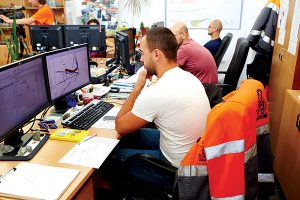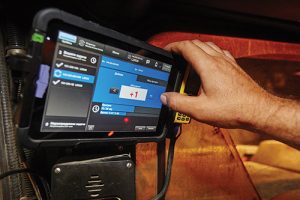Dundee brings its underground WiFi to market with Terrative Digital Solutions
When Mark Gelsomini, an IT professional with a background in computer engineering, joined Dundee Precious Metals in 2009, it was during the market turmoil of the financial crisis.

Mark Gelsomini
“Gold prices were dropping, the housing market was dropping, the U.S. was going through a recession,” Gelsomini recalls. “Mining companies were trying to improve productivity without adding equipment or people.” Over the next few years, Gelsomini, now the company’s corporate director of information technologies, succeeded in helping Dundee do just that at its Chelopech gold mine in Bulgaria. Tasked with “taking the lid off the mine,” by Dundee COO (now CEO) Rick Howes, and finding a way to gather information in real time, Gelsomini and his team turned the more than 60-yearold underground mine into one of the most technologically advanced in the world.

The office at Dundee Precious Metals’
Chelopech copper-gold mine, in Bulgaria.
By adapting existing Wi-Fi technology to the underground mining environment, and developing its own software, the company was able to collect and analyze operating information as it was generated. As a result, Dundee was able to quadruple production and cut its costs per tonne, without additional labour and equipment.
As news of the company’s achievements has gotten out, Dundee has been inundated by mining companies that want to buy its technology.
“We were getting a lot of interest in our technology and we had a number of other mining companies and other companies go through our operations looking at the Wi-Fi, looking at the costing around it,” Gelsomini explains. “They kept asking, ‘How do we get it?’” Now, they can.

Mine360 software on a vehicle operator
tablet.
Terrative Digital Solutions, a subsidiary of Dundee focused on developing digital technology for remote and underground mines, is having its official launch at the CIM convention in Montreal Apr. 30-May 3.
The decision to launch Terrative had a dual purpose: to help commercialize Dundee’s technology and to establish a separate R&D division so that Dundee can remain focused on its primary business of mining.
Terrative already has several clients, including leading mining customers, says Gelsomini, who is also vice-president technology at Terrative.
“The mine itself, the material that you’re mining, causes what we call the proverbial black hole,” Gelsomini explains. “So you may have an access point – you may have wireless there but getting absolutely no coverage.
So what’s happening is that that wireless is actually being absorbed by the rock.” As a result, Dundee developed its own custom antennas, which Gelsomini says improve coverage significantly. Whereas traditional access point spacing is limited, Dundee has been able to increase that distance due to their antenna design. The result is fewer access points required to achieve what they call “pervasive” Wi-Fi coverage.
“We have 360 access points in our flagship Chelopech mine,” Gelsomini says.
“If we were to use traditional antennas, which are much more expensive, the number would have to be significantly higher.” Because they’ve adapted existing, low-cost technology, Terrative’s access points cost considerably less than their competitor’s.
Software
The second part to Dundee’s innovation was its Mine 360 software, which it uses for maintenance control, work orders, scheduling, short interval control, and tracking of equipment and employees. Using data transmitted by Wi-Fi from tablets used by underground mine operators and sensors and RFID tags on equipment and employees, the software offers full visibility of an operation – a 360 degree view.
Dundee chose to develop its own software so that it could introduce new features as needed in a timely way without having to rely on a third-party vendor.
“The challenge is if you want (a vendor) to make a change to a software app to suit your needs, there’s a long process,” Gelsomini says. “The main point of building your own is that agile approach – well I want it to do this now.” It may be unusual for a mining company to develop its own software, but it’s common for companies in other sectors such as manufacturing and banking to have custom software apps or to build one in-house.
Gelsomini says it was actually cost-effective for Dundee to develop the software in-house. “We knew what we wanted and how quickly we needed it and how quickly we would want to change it,” he says. And in the five years since it first developed its technology, Dundee is already on its 6th Generation of the technology.
“A traditional mine that doesn’t have this capability, they can’t flip their technology as often as they want,” Gelsomini notes.
“The advantage of our solution is it’s low cost and modular, therefore inexpensive to replace and expand versus a traditional mining-specific communications systems. A leaky feeder system will have a much higher total cost of ownership, and provide a fraction of the functionality and bandwidth.” As a former outsider to the mining industry and one of few IT professionals with a prominent role in the sector, Gelsomini has a unique perspective on the sector’s need for and simultaneous resistance to innovation.
“There’s a lot of conversation about it, there’s a lot of interest in it, but few are actually doing it to the extent we are, and, more importantly, driving the same outcomes,” Gelsomini says.
Part of it is confusion about what innovation actually is, he notes, adding that it is definitely not about optimization or improving processes.
When we’re talking innovation, we’re talking about bringing in technology or ideas that traditionally did not exist underground or in mining at all and applying them to the mining sector. That’s innovation,” he says.
“To me, the mining sector is almost on the precipice of saying, ‘we’re ready to jump.’”
Comments